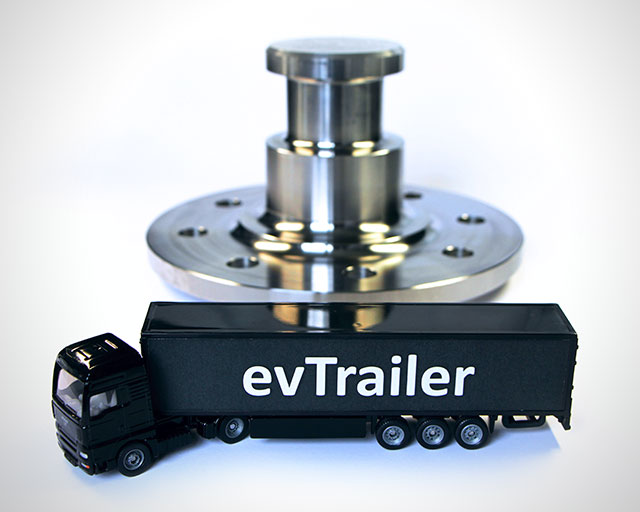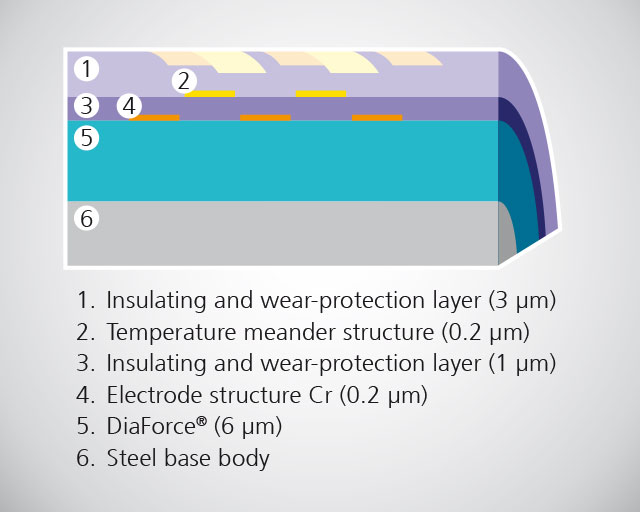
Development of a sensory kingpin

With the objective of reducing the energy consumption as well as CO2, noise, and brake dust emissions when using vehicle trailers, an innovative propulsion and control system has been developed for vehicle trailers as part of the ev (electric vehicle) project funded by the BMWi. The outstanding feature is the manufacturer-independent autonomous mode of operation of the evTrailer, which functions with any conventional tractor unit.

At the Fraunhofer IST, within the project a piezo-resistive thin-film system is used to measure force, this system is directly precipitated onto the complex shape of the mechanical connecting link between tractor unit and trailer, the so-called kingpin (see adjacent figure). Interaction of the applied components, specifically force measurement sensors, electric powertrain module, traction battery, and battery management system, is ensured through intelligent control algorithms.
Task of the sensory kingpin
The sensory film system developed at the Fraunhofer IST for local tensile force measurement is precipitated and structured directly on the three-dimensional surface of a kingpin. With these measurement results, an adjustment occurs that should compensate the tensile force or shear force that occurs in the trailer coupling. This means that the energy generated by the braking power, which is recovered via the electric motors at downhill travel, and which is stored in batteries will, if needed i.e. for uphill travel or for acceleration processes, again be available to the vehicle as drive power. Depending on the load status and the control strategy, the tractor “feels“ neither the pull nor the push of the attached evTrailer. Thus, the tractive unit is offloaded, which means that less energy is consumed and CO2 emissions are minimized.
Development of the sensory kingpin
Within the project, the task of the Fraunhofer IST is the integration of the thin-film sensors for measuring the load and temperature distribution in the main load zone of the kingpin, which weighs 6 kg. For this, the film system presented in the adjacent figure is precipitated and structured on the manually polished surface of the kingpin in such a manner that the measurement areas are located in the upper part. The conductive traces to the contact area must be routed over several edges, so that they can be arranged in the lower screw connection area. The figure above shows the complexity of the structuring, in which the photolithography and the wet-chemical etching are combined. The structures running horizontally will later be in direct contact with the locking hook of the fifth-wheel coupling and they will measure the forces occurring under strong frictional load. The meander-shaped structures measure temperature.
Outlook
After the successful manufacturing of the multi-sensor thin-film system on the kingpin surface, the characteristic curves of the piezo-resistive and thermo-resistive sensor structures will be recorded and combined with the measurement technology of the project partner CuroCon GmbH. Then, the functionality of the thin-film system will be verified in test runs with a semitrailer from the company Wilhelm Schwarzmüller GmbH.
The project
The described results were achieved within the »evTrailer« project, in which the Fraunhofer IST takes part, together with the Fraunhofer Institute for Structural Durability and System Reliability (Fraunhofer-Institut für Betriebsfestigkeit und Systemzuverlässigkeit (LBF)), the Institute for Internal Combustion Engines and Powertrain Systems (Institut für Verbrennungskraftmaschinen und Fahrzeugantriebe (VKM)) at the Technical University of Darmstadt and the companies CuroCon GmbH and OSWALD Elektromotoren GmbH. The project is funded through the Federal Ministry for Economic Affairs and Energy (BMWi).
This article is part of the annual report 2018.

